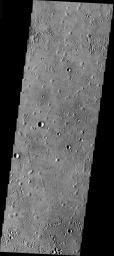
|
A Martian Christmas Present
- Click the image above for a larger view
- Full-Res JPEG (1433 x 3227) (701.5 kB)
- Full-Res TIFF (1433 x 3227) (3.6 MB)
Caption:
Released 24 December 2003
If all goes well, tonight at 6:54 pm PST the British robotic spacecraft called Beagle 2 will land on a patch of ground somewhere in this scene. This THEMIS image covers a portion of the Isidis Basin at the center of an elliptical region predicted to be the location that Beagle 2 will bounce to the surface. And what a surface it is, pockmarked by strange pits and unusual cones whose origin remains enigmatic. The cones may be the result of lava flowing over ice or water-rich ground resulting in explosions of steam that build small "rootless" volcanoes. The pits look like secondary craters that result from the impact of ejecta from larger craters. But they appear too numerous and densely clustered for that explanation. Instead, they also may be the result of some process involving water or ice. With luck, Beagle 2 will survive its violent landing and provide clues to the origin of this unusual landscape and answer questions about the role of water in Mars history.
Image information: VIS instrument. Latitude 11.7, Longitude 90.4 East (269.6 West). 19 meter/pixel resolution.
Note: this THEMIS visual image has not been radiometrically nor geometrically calibrated for this preliminary release. An empirical correction has been performed to remove instrumental effects. A linear shift has been applied in the cross-track and down-track direction to approximate spacecraft and planetary motion. Fully calibrated and geometrically projected images will be released through the Planetary Data System in accordance with Project policies at a later time.
Background Info:
NASA's Jet Propulsion Laboratory manages the 2001 Mars Odyssey mission for NASA's Office of Space Science, Washington, D.C. The Thermal Emission Imaging System (THEMIS) was developed by Arizona State University, Tempe, in collaboration with Raytheon Santa Barbara Remote Sensing. The THEMIS investigation is led by Dr. Philip Christensen at Arizona State University. Lockheed Martin Astronautics, Denver, is the prime contractor for the Odyssey project, and developed and built the orbiter. Mission operations are conducted jointly from Lockheed Martin and from JPL, a division of the California Institute of Technology in Pasadena.
Cataloging Keywords:
| Name | Value | Additional Values |
|---|---|---|
| Target | Mars | |
| System | ||
| Target Type | Planet | |
| Mission | 2001 Mars Odyssey | Mars Express, Mars Express (MEX) |
| Instrument Host | Mars Odyssey | Mars Express Lander |
| Host Type | Orbiter | Lander |
| Instrument | Thermal Emission Imaging System (THEMIS) | |
| Detector | ||
| Extra Keywords | Crater, Grayscale, Impact, Thermal, Volcano, Water | |
| Acquisition Date | ||
| Release Date | 2004-01-03 | |
| Date in Caption | 2003-12-24 | |
| Image Credit | NASA/JPL/Arizona State University | |
| Source | photojournal.jpl.nasa.gov/catalog/PIA04949 | |
| Identifier | PIA04949 | |
